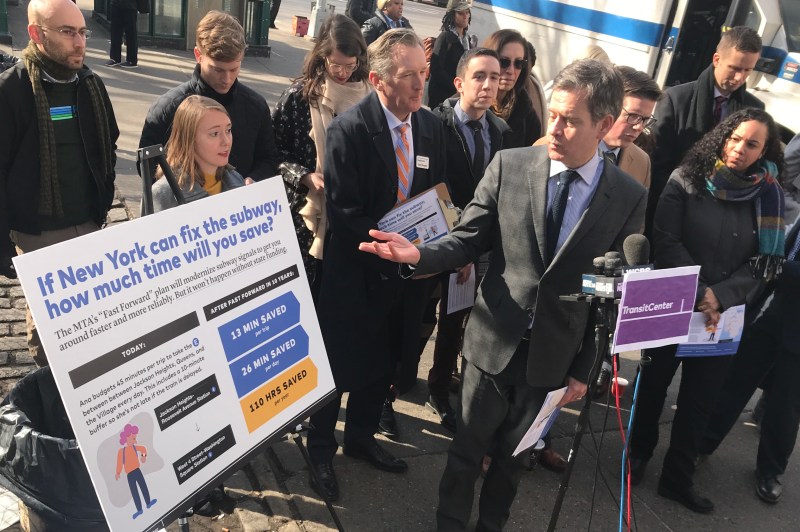Another Benefit of Congestion Pricing? Commuters Will Have Way More Time

Congestion pricing will save money and it will save lives — but it will also save New Yorkers hundreds of hours of stressful commuting.
A new analysis by TransitCenter revealed just how much time: 110 hours per year in unnecessary delays for a typical commute from Jackson Heights to the West Village on the E train, 43 hours per year for a commute from the South Bronx to Canal Street on the 6 train, and 36 hours for a C train commute from East New York to Downtown Brooklyn.
The pro-transit group, which supports congestion pricing as a crucial revenue stream for the cash-strapped MTA, hopes the numbers will pressure outer-borough lawmakers who are reluctant to support tolling drivers even though doing so would benefit the vast majority of their constituents who use transit every day (fact sheet below). The analysis was based on existing wait times on platforms, delays, excess “buffer time” that commuters build into their rides and previously unreleased train arrival data from the MTA.

New York City Transit President Andy Byford has put forward a $40- to $60-billion plan to rehabilitate transit across the board, including a subway system burdened by 1930s-era signals across multiple lines. The TransitCenter numbers don’t even take into account time savings that could be achieved if buses are moving faster, thanks to congestion pricing, dedicated lanes or improved enforcement against drivers who block transit, which Mayor de Blasio has recently promised. (Riders Alliance did its own study of the hours that bus riders will save.)
But very little of the so-called “Fast Forward” plan can be achieved without the $15 billion in bonding power created by congestion pricing.
In its most eye-popping statistics, TransitCenter singled out several opponents of the tolling scheme to demonstrate how horrible their constituents’ lives are right now. Queens State Senator Leroy Comrie’s 25,000 subway-riding constituents, for example, would collectively save 838,000 hours per year. Neighboring Senator Joe Addabbo’s subway riders would collectively save more than 1 million hours per year.
Yet both oppose congestion pricing, even though a tiny fraction of residents of their district regularly commute by car into the congestion zone. That opposition appalls supporters of the tolling scheme because it suggests that Comrie, Addabbo and other opponents are simply bad Democrats.
“Fast Forward helps the outer boroughs more than Manhattan,” said Assembly Member Bobby Carroll of Brooklyn. “IN my district, if you’re going to work and the F train shuts down, you have nowhere else to go. So this is the plan for the outer boroughs! It is insane that Andy Byford and others haven’t come out and made that clear. Fast Forward is the way we help working class people in the boroughs. I don’t know why they aren’t shouting that from the rooftops.”
Many have been. But the message is not being received.
Senator Roxanne Persaud of Queens said that she “has some concerns” about tolling Manhattan-bound drivers because her district is a “transportation desert,” said her spokesman Matthew D’Onofrio.
“Many residents drive,” he added. “At this time, she is still looking into what’s best for her constituents.”
What is best for her constituents is transit. According to data compiled by the Tri-State Transportation Campaign, three percent of Persaud’s commuters regularly drive into the central business district of Manhattan, while the majority take transit to work. And in Persaud’s disadvantaged district, the median income of drivers is more than $13,000 per year higher than that of transit riders.
Meanwhile, a new analysis by CHEKPEDS, the Chelsea-based pedestrian group, showed that Persaud’s driving constituents would save 70 minutes per week, or 58 hours per year. That data was built on research from transportation analyst Charles Komanoff.
The group’s analysis also showed that congestion pricing would save 71 lives currently lost to road crashes and result in 17,000 fewer injuries in its first two years.
“Achieving such significant reduction in crashes without having to wait years and spend millions of taxpayers’ dollars is an opportunity we cannot miss,” said Christine Berthet, CHEKPEDS co-founder.
Congestion Pricing will Eventually Save Transit Riders up to over 100 Hours Per Year! from STREETFILMS on Vimeo.





